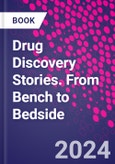Drug Discovery Stories: From Bench to Bedside presents a collection of cases on the development of highly successful pharmaceuticals. It delves into the realm of drug discovery, exploring the structural biology and biological functions of the sought-after targets. The book covers the identification of promising compounds, their transformation from hits to leads through meticulous optimization, and the elucidation of how key compounds interact with the target (in essence, providing invaluable insights for drug design). Additionally, it covers essential information such as the pivotal biological and PK data of lead compounds, any noteworthy clinical results, and a comprehensive overview of other candidate compounds.
The field of drug discovery and development has experienced rapid evolution, with numerous new drugs receiving approval each year. While several books have been published on this subject, there is a pressing need for a new book series that accurately reflects the current advancements in drug discovery. This book aims to not only cater to the drug discovery community but also engage other communities involved in chemical biology, synthetic chemistry, and pharmacology.
Please Note: This is an On Demand product, delivery may take up to 11 working days after payment has been received.
Table of Contents
Section 1: Drug discovery techniques and Strategies
1. Artificial Intelligence in Early Stages of Structure-Based Drug Discovery
2. Target-based vs Phenotypic drug discovery: Opportunities and challenges with evidence-based application
3. Hit Discovery from DNA-Encoded Chemical Libraries
4. Discovery of Lead Compounds from Pseudo-Natural Macrocycles Enabled by Modular Biomimetic Strategy
5. Macrocyclization strategy in kinase drug discovery
6. Cobalt catalyzed C-H functionalization for the synthesis of chiral heterocyclic molecules
7. Advancing Proteolysis Targeting Chimeras towards Clinical Drug Developments
8. A future battle, small molecule drugs for cancer stem cell targeted therapy
9. Stem cell therapies for combating emerging and re-emerging viral infections
10. Targeting Autophagy with Pharmacological Small-Molecules to Treat Human Diseases
11. Interferons in human papillomavirus infection: antiviral effectors or immunopathogenic role?
12. Selenium and small molecules: a symbiotic partnership
13. Novel Combinations of CD33-Targeted Immunotherapies
14. Novel payloads of antibody-drug conjugates
15. Antibody-Drug Conjugates (ADCs): A New Generation of Cancer Vaccines
16. mRNA Vaccines: The Next Frontier in Disease Prevention
17. Unravelling the drying techniques of protein biopharmaceuticals
Section 2: Drug discovery case studies
18. Lenacapavir: a first-in-class HIV-1 capsid inhibitor for the treatmet of multidrig-resistant HIV infections
19. Nirmatrelvir, SIM0417, and RAY1216: Potent and Selective SARS-CoV-2 Main Protease Inhibitors for the Potential Treatment of COVID-19
20. ARV-110: An Androgen Receptor Degrader in the Treatment of Metastatic Castration-Resistant Prostate Cancer
21. Darolutamide: An Androgen Receptor Antagonist for the Treatment of Prostate Cancer
22. Palbociclib, Ribociclib, and Abemaciclib: Potent and Selective CDK4/6 Inhibitors for the Treatment of Breast Cancer
23. Zanubrutinib: A breakthrough in cancer therapy targeting BTK, originating from China and benefiting the global community
24. Discovery of FT-2102 (olutasidenib), an inhibitor of mutant isocitrate dehydrogenase 1, for treatment of relapsed or refractory acute myeloid leukemia
25. Ziftomenib (KO-539): A Potent and Selective Menin Inhibitor for the Treatment of Recurrent or Refractory Acute Myeloid Leukemia
26. Pulrodemstat (CC-90011): A Potent, Selective, and Reversible LSD1 Inhibitor
27. Mavacamten, a First-in-Class Cardiac Myosin Inhibitor for the Treatment of Hypertrophic Cardiomyopathy
28. Verquvo, a First-in-Class Soluble Guanylate Cyclase (sGC) Stimulator for the Treatment of Heart Failure
29. Tafamidis: a Transthyretin Stabilizer for Rare Cardiac Amyloidosis
30. Oliceridine (TRV-130): A Biased Agonist of the ? Opioid Receptor as a Novel Analgesic
31. Sotyktu (Deucravacitinib): The First TYK2 Inhibitor Approved for the Treatment of Psoriasis
32. Bexagliflozin: A SGLT-2 Inhibitor as Antidiabetic Drug Derived From Phlorizin
33. Antidiabetic Drugs Targeted PPAR?: From Full Agonists to Selective Modulators
34. Pretomanid: an antibiotic used for the treatment of multidrug-resistant tuberculosis
35. Lecanemab (Leqembi): An Amyloid Beta Monoclonal Antibody Approved for the Treatment of Alzheimer's Disease








